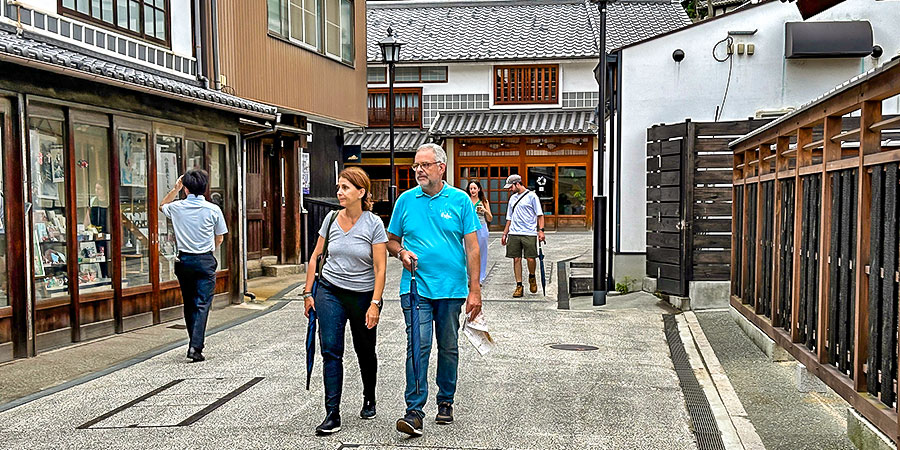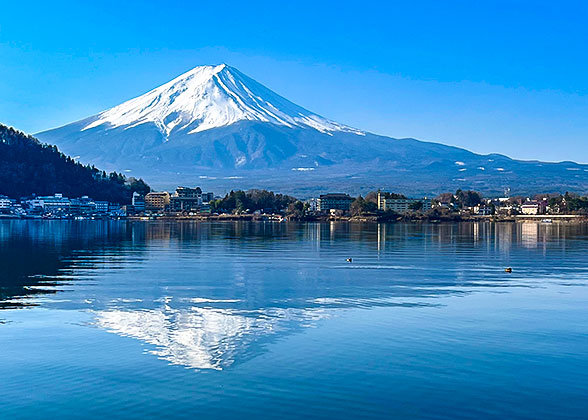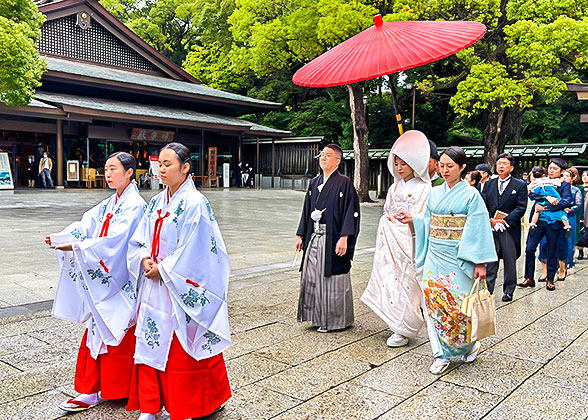Bikan Historical Area
Bikan Historical Area is in western Okayama, and the Kurashiki River flows through this historical quarter. It preserves many merchant houses and warehouses with white walls and black tiles and blending Japanese and Western styles from the Edo period (1603-1868), which is very distinctive. Traveling there, you will feel like going back to ancient Japan.

The street of Bikan Historical Area
|
Many of the old houses are nowadays used as restaurants, cafes, clothes shops, and boutique stores, etc. Besides, the Bikan Historical Area boasts a number of cultural facilities helping create artistic atmosphere, including the Ohara Museum of Art, which houses world-famous paintings; the Kurashiki Ivy Square, which was developed from the representative textile factory ruins in Kurashiki; the Kurashiki Museum of Folkcraft, which houses about 700 folk crafts; and the Kurashiki Archaeological Museum.
This unique place not only attracts many visitors, but also local newlyweds to take wedding photos to commemorate the most beautiful moments in their lives.
Once a Prosperous Goods Distributing Hub
Bikan Historical Area used to be a distributing hub of rice, salt, and cotton, with boats carrying goods coming and going every day. As more and more warehouses were built along the banks of the river, the place became more and more prosperous and the name “Kurashiki” came into being, literally meaning “goods in warehouses”.

Kurashiki River in Bikan Historical Area
|
Four Places Not to Be Missed in Bikan Historical Area
1. Ohara Museum of Art
Kurashiki Bikan Historical Area
The Ohara Museum of Art consists of the main hall, which houses Western paintings; the branch hall for Japanese paintings; and the Craft Art Gallery & Asiatic Art Gallery, which exhibits works from the Japanese folk art movement and ancient artworks from East Asia. Additionally, there is a souvenir shop inside.
Ticket: Adults: 2,000 yen; Children below 6 years old: free of charge.
Opening time: 9:00-17:00, last admission at 14:30; Closed on Mondays.
2. Ohashi Residence
In the Bikan Historical Area, there are several merchants’ mansions from the late 18th century that have been restored and opened to visitors. One of these is the Ohashi Residence, which is a typical folk mansion in the Kurashiki area. The main house has been carefully preserved to maintain its original appearance, and features a long entrance corridor, white walls tiles, round tiles with family emblems on the eaves. Additionally, instruction manuals in English are available for visitors in the main room.Ticket: Adults: 550 yen; Children under 12 years old and seniors over 65 years old: 350 yen; Tickets for groups with 20 or more adults: 450 yen
Opening time: 9:00 - 17:00
3. Hayashi Genjuro Shouten
Hayashi Genjuro Shouten is the most representative old store in this Bikan Historical Area. The building used to be a century-old pharmacy, and it was later transformed into a three-story marketplace that features Japanese miscellaneous goods, stationery stores, and cafes. It doesn't look like a store, but more like a place where various artworks are gathered. Here, tourists can buy a variety of exquisite small crafts and daily necessities, such as beautiful cups, postcards, and various types of tape. Especially if you are a scrapbook lover, you will definitely take home a full haul of purchases.Opening time: 10:00 - 18:00
4. Momotaro's Karakuri Museum
Momotaro's Karakuri Museum is a place dedicated to Momotaro, a character from Japanese mythology. There are two floors in total. The first floor serves as a machine house where each machine is handcrafted by the owner, which is different from other places. Additionally, there is a shopkeeper available, providing guidance on how to operate each machine. The second floor is the Momotaro story display area, which shows some movie and television works about Momotaro.Ticket: Adults: 600 yen; Children at or below five years old: 100 yen.
Opening time: 10:00 - 17:00
|
|
|
Unique Food You Can Eat in Bikan Historical Area
1. Steamed Buns and Ice Cream in Blue Denim Color
Kurashiki is the birthplace of denim clothing, so the elements of denim are also incorporated into the food. This denim blue color is not dyed with pigment, but dyed with gardenia, and it is safe to eat. The steamed buns taste soft and the filling is made of fresh and delicious pork. The ice cream is made with blueberries. Besides, they are great to use as props for photo shoots to make your photos more colorful.Reference price: Steamed bun: 350 yen/each; Ice Cream: 380 yen/each.
2. Miffy-Shaped Breads
When you come to the Bikan Historical Area, Miffy's Kitchen is a store not to be missed. The store has various flavors of Miffy-shaped breads, with the most popular being the red bean buns, which are soft and not too sweet. There's a long line for bread at this store every day, so get there early if you want to savor it.Reference price: 3,000 – 4,000 yen per person.
3. Gold Prize Croquette
The Gold Prize Croquette is the colcannon that won the Japan Colcannon Competition in 1987. The outer layer is made of Hokkaido potatoes for a crispy texture, and the filling is juicy made of Japanese wagyu beef.Reference price: 1,000 yen per person.
The Bikan Historical Area is also worth a visit for its sake and fried pork chops. Additionally, this area is known for producing denim products, with many shops along the street selling denim clothing and dolls.
Interesting Ways to Tour Bikan Historical Area
1. By Cruise Boat

A boat in Bikan Historical Area
|
Ticket: Adults: 500 yen; 5-12 years old: 250 yen; Below 5 years: free of charge.
Departure time: 9:30 - 17:00, every 30 minutes.
Tip: Usually, the tickets are sold out before 4 p.m.. If you want to take the boat, please buy in advance.
2. Tour by Rickshaw
Rickshaws offer a charming way to explore the Bikan Historical Area. Friendly coachmen will guide visitors through the various attractions, sharing insights into the surrounding architecture, history, and culture. Many of them are also fluent in foreign languages such as English, making it easier for international visitors to enjoy their service.Note: The price of the rickshaw service may change at different times. The approximate fare is 9,000 yen for a 30-minute ride alone and 10,000 yen for two people.
How to Get to the Bikan Historical Area

JR Kurashiki Station
|
Admission Fee: Free admission
Recommended Touring Time
The optimal visiting duration is 4 to 5 hours. It is important to note that most shops close before 5 p.m..
You May Like
-
 10 Days Private Tour of Tokyo - Mt. Fuji - Nagoya - Takayama - Shirakawa-go - Kanazawa - Kyoto - Nara - Hiroshima - Osaka from USD3756
10 Days Private Tour of Tokyo - Mt. Fuji - Nagoya - Takayama - Shirakawa-go - Kanazawa - Kyoto - Nara - Hiroshima - Osaka from USD3756 -
 7 Days Classic Mini Group Tour with Highlights in Japan: Tokyo - Mt. Fuji - Kyoto - Nara - Osaka from USD2155
7 Days Classic Mini Group Tour with Highlights in Japan: Tokyo - Mt. Fuji - Kyoto - Nara - Osaka from USD2155 -
 21 Days Long Private Tour of Tokyo - Mt. Fuji - Nagano - Kanazawa - Shirakawa-go - Takayama - Nagoya - Nakasendo Way - Kyoto... from USD8491
21 Days Long Private Tour of Tokyo - Mt. Fuji - Nagano - Kanazawa - Shirakawa-go - Takayama - Nagoya - Nakasendo Way - Kyoto... from USD8491

